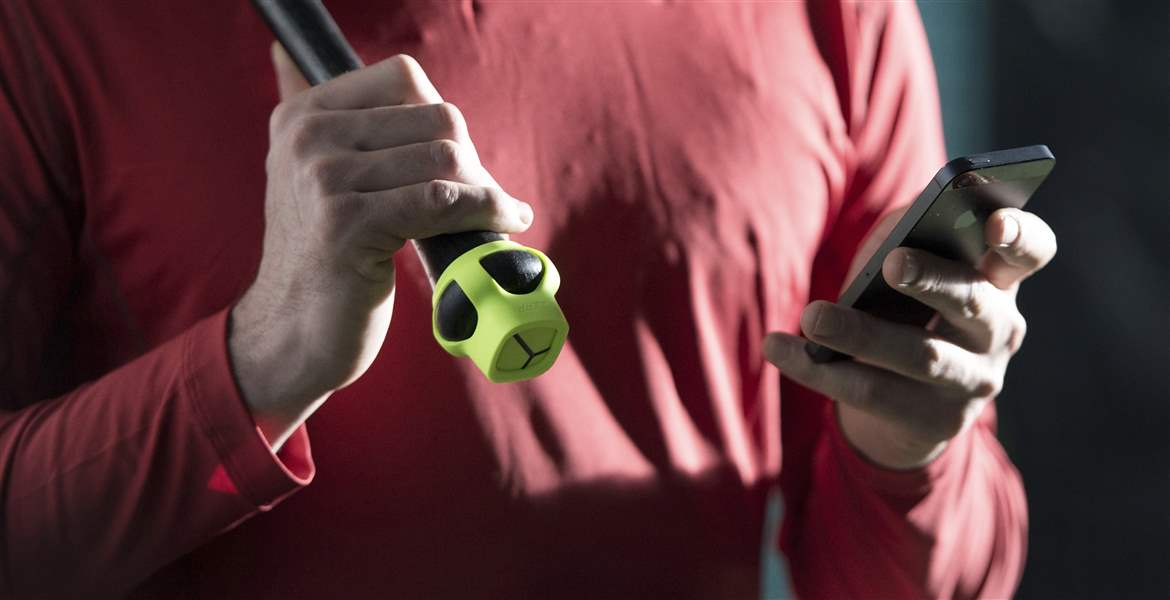
Sports gear takes bigger byte
Digital devices on bats, balls, clubs get in as virtual coach
1/18/2014
The Zepp, a fluorescent-green square sensor that snaps into one of three rubber mounts for golf clubs, tennis rackets, and baseball bats, measures aspects of a user’s swing and sends the information via Bluetooth to an app for analysis on a smart phone or tablet.
NEW YORK TIMES

NEW YORK — The tech world’s obsession is with wearables — the idea you can stuff all manner of technology into increasingly tiny packages.
So far, much of the attention has been on watches and glasses. But the same teeny sensors and smart-phone brains that power those devices have other applications — for instance, in a new wave of smart sports equipment.
In the last year, companies have started introducing some intriguing sports devices that analyze movement using sensors, in particular multiaxis accelerometers (for measuring linear acceleration) and gyroscopes (for measuring orientation).
The point of all these gadgets, in essence, is to put a digital coach into your pocket.
Take the Swingbyte, one of a few of these new devices I stuffed into my gym bag to see if they were useful to a 40-year-old recreational athlete like me.
The Swingbyte is a $150 plastic doodad about the size of a jumbo pack of Juicy Fruit that breaks down your golf swing. The original version had a glorified rubber band that helped attach the device to a club, but Version 2.0 has an intricate latch with a theoretically tighter grasp. Then when you swing the club, the device sends data by Bluetooth to your tablet or smart phone, where an app collects the data and spits back a pile of information and analysis that means something to people who understand things like face angle and swing path.
I’m not one of those people, and I’m a terrible golfer, so I invited a pro at Chelsea Piers in Manhattan, John Hobbins, to hang out, hit golf balls, and look at data.
Some of Chelsea Piers’ teaching pros use the Swingbyte, Mr. Hobbins told me, but mostly for putting. He was skeptical of its accuracy.
“My take on things like that is that you get what you pay for,” he said.
The radar-based swing analysis system used by the Golf Academy, a school at Chelsea Piers, costs $15,000, he said.
And my results did not win him over. Most troubling, the Swingbyte’s latch, which seemed to snap snugly onto the club, popped open on many swings and slid down the shaft. That was distracting, and skewed some data. The Swingbyte did seem to accurately pick up the club head speed, though, as well as other crucial data points, such as the ratio of my backswing to forward swing. And the app was a thing of beauty — slick, clean, and easy to use (though also a significant drain on my iPhone’s battery).
When I reported my issue with the unit’s stability to the company, I was told it was probably just a faulty latch. So the company mailed me a new one, which popped easily into place on my existing Swingbyte. A week later, I tried it out. Problem solved.
Technical difficulties followed me to the basketball court, where I pulled out the 94Fifty, a $300 app-enabled basketball that you can buy at the Apple Store. The 94Fifty is impressive: It is a regulation basketball with a built-in suite of sensors that, like the Swingbyte, transmits data in real time to an app. It also recharges wirelessly.
My first attempt with the ball was a bust. It would not sync with my phone; it was the wrong size. In the chaos of the holidays the company had sent me a women’s ball, smaller than the one I usually play with. Once I had my hands on a new and NBA-size ball, though, it synced immediately and did everything the company promised. It was fun. A canned voice even yells at you like a real-live coach.
I had the best luck out of the box with the $150 Zepp, a fluorescent-green square that snaps into one of three rubber mounts for golf clubs, tennis rackets, and baseball bats. I opted for the baseball bauble, which attached easily to the base of a 28-ounce aluminum bat I plucked from the racks of the slow-pitch batting cages that I was sharing with a grade-school birthday party.
After the first 10 balls, I checked my results. At the level I sought to be, Zepp says, I should have an average bat speed of 80 mph. Mine was 56. My other measurements — the horizontal and vertical angles of my swing, as well as the time the barrel of my bat was in the strike zone — were closer to fine, but then again I was swinging at 35-mph pitches that I probably could have hit with a pool noodle.
Was any of this helpful? The Zepp will not get me recruited to any league games anytime soon. But it worked, easily, and helped make an otherwise repetitive activity a little bit less monotonous.
None of these devices, nor the others coming soon, including a new tennis racket from Babolat called the Play Pure Drive and the Adidas miCoach soccer ball, will replace coaches anytime soon. But they could be used to enhance coaching.
Without interpretation, data are just numbers, and even with slick app presentations, it is still hard to parse if you’re not an expert.
For that reason, the apps allow you to email the results to a coach, or share them via social media, if you just feel like letting others know you can swing a bat (barely) faster than a 12-year-old. Once you know what good form looks and feels like, you can use the devices on your own to develop muscle memory through repetition.